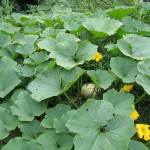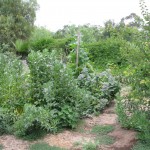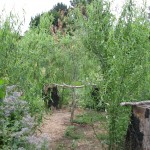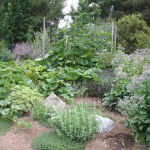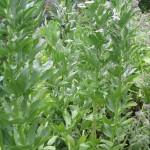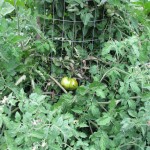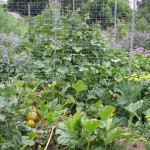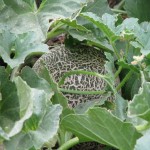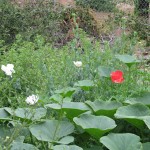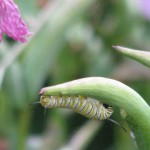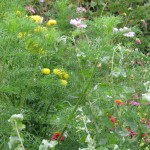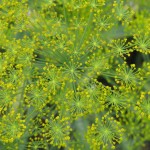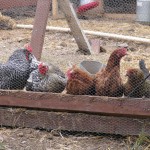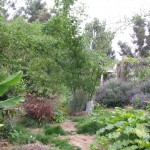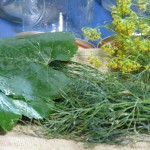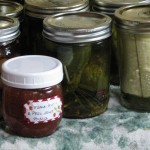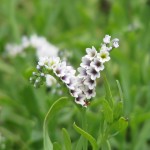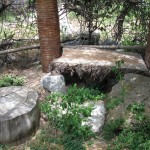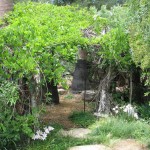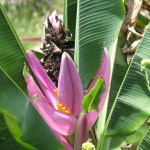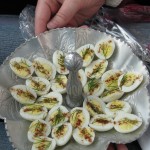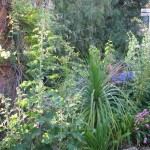- Gardening adventures, Heirloom Plants, Permaculture and Edible Forest Gardening Adventures, Vegetables, Vegetarian
Fun Vegetables

A small green zebra, not quite ripe In a past post I related how my mother had witnessed a woman staring hands-on-hips at the produce selection in a grocery store and exclaiming, “I wish they’d come up with some new vegetables!” How true is that? How many ways can you cook the limited offerings in your average supermarket produce section without going out of your mind? That’s where a trip to an ethnic grocery store can be a life-saver. Or, plant some fun new varieties in your garden.
Thanks to Baker Creek Heirloom (Organic) Seeds and their fantastic catalog, I was spoiled for choice. I also buy a lot from Botanical Interests , an organic seed company which has packets for sale in stores such as my neighborhood Joe’s Hardware. Their wildflower seed mixtures are highlights of my garden and attract birds, butterflies and other insects. Here are some newbies I tried this year, and the keepers:
Zucchino Rampicante : an heirloom zucchini that grows on a vine. This squash grows curled or straight on long vines that need support. The fresh squash can be used like zucchini, but are firmer and have a mild butternut flavor that goes well with everything. I am completely in love with the taste of these.
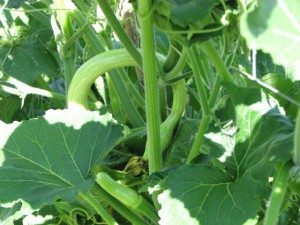
Some zucchinos are straight, some follow their own tune PLUS: if you leave the squash on the vine, it grows huge and unlike those monsterous zucchini clubs that are practically inedible and unwanted, zucchino then hardens and you can store it and use it as a winter squash! How marvelous and unwasteful is that! Zucchini without the pressure. No more alienating your neighbors and friends with excess squash.
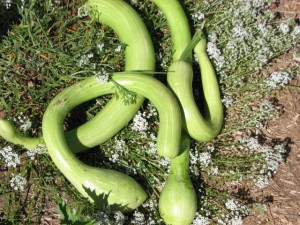
Zucchino shapes are marvelous Green Zebra Tomato :a large, lime-green striped tomato that develops a slight yellowish tinge between the stripes when ripe. These gorgeous tomatoes are rich and slightly tart, but without heavy acid. Marvelous on a open-faced sandwich or in a caprese salad to show off the color inside.
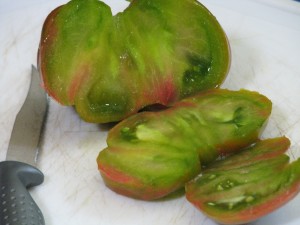
Green Zebra: beautiful inside Thai #2 Red Seeded Long Bean: The seeds were given to me by the woman who introduced me to Baker Creek Seeds, and who built my chicken and quail coops. I planted the seeds by stakes that turned out to be too short for the vines.
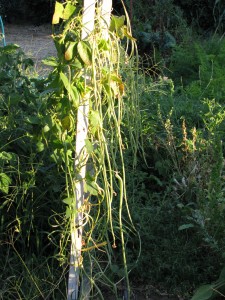
Long beans growing very long. However, these beautiful flowers eventually came, followed by spectacularly long thin green beans two feet long! One bean per person! (Just about, anyway). They are good stir-fried. I haven’t tried to tempura one yet, but its tempting.

Six long beans slice up to a serving for two! Mortgage Lifter Tomato : Now THESE are the ultimate sandwich tomato. These heavy pink-red fruits have mostly meaty insides and have an incredible savory flavor. I have found my favorite red tomato. Beefstake has nothing on this baby. It also has a cool name.
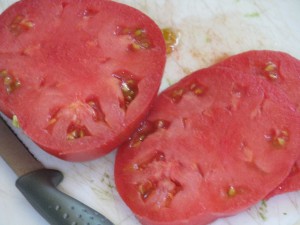
Mortgage Lifter is very meaty and savory 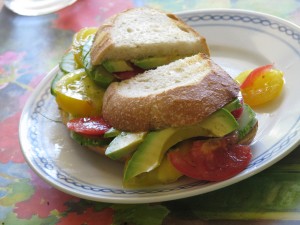
Rice Blue Bonnet: the jury is still out on this one. This is a dry-land rice. I didn’t thin it when I should have, so it is growing in clumps and hasn’t progressed beyond the thin leaves. My fault. It is growing and would probably be successful if I handle it right.
Basil Custom Blend HEIRLOOM Seeds : I planted a row and have regular and purple basil, lime basil, and cinnamon basil (one of my favorite scents). Today I used the regular and purple chopped over an open-faced tomato sandwich, and my daughter added leaves from the other two to a fruit salad.
Sesame, Light Seeded : Beautifully flowered plants with seed pods full of sesame seeds! How great is that?
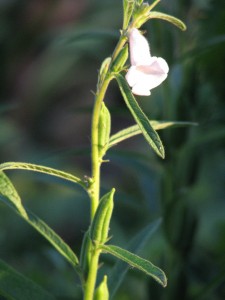
Sesame pods. Broad Windsor Fava Bean : I planted a lot of legumes to help build the soil (they set nitrogen), and tried fava beans this year. They grow like crazy, take a lot of neglect, and produce a fantastic protein source in the form of a tasty bean. They are a little trouble to shell, but well worth it. I wrote about favas here.
Blue Potatoes: These I started several years ago from an organic blue potato I bought at a grocery store. Since there are usually some small tubers left in the soil, I have volunteers sprouting every year. These blue potatoes – whatever their true variety is – are a lovely purplish blue outside, with a lovely purple center as well. They aren’t starchy, but are best used like red potatoes. Very fun.
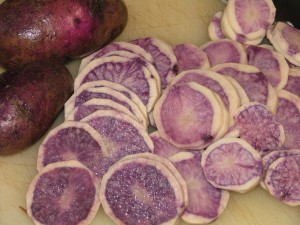
Peeled purple potatoes - Animals, Chickens, Gardening adventures, Heirloom Plants, Herbs, Other Insects, Permaculture and Edible Forest Gardening Adventures, Photos, Ponds, Quail, Vegetables
What’s Happening in the July Garden
A banana squash stealthily growing huge An apricot tree with fava beans, squash, herbs, artichokes, and tomatoes The withy hide growing beautifully Kabocha and delicata squash on the ground, zucchino rampicante on the trellis, Christmas beans, favas, Swiss chard and medicinal plants around a small avocado tree Favas: great for the soil, great for the dinnerplate Heirloom tomatoes. Why do they all come ripe at the same time? Sugar pumpkins are ripe already in the Mediterranean guild. Also figs, paste tomato, dill, fennel, thyme, pickling cucumbers and artichoke. Plant guilds of squash, beans, flowers, etc. are flourishing. Heirloom green melons hiding from the hot sun. By now the wild buckwheat has dried up, which starves the bees. But not here. Matilija and Flanders poppies over banana squash Monarchs are so plentiful this year that we have to take pains to avoid them. Wildflowers host an incredible diversity of insects Dill flowers looking like a spectacular firework In a balanced wildlife habitat, bunnys do little harm All five girls waiting for treats in the Fowl Fortress Pumpkins, bananas, bamboo and much more by fescue paths. Fresh grape leaves, dill and garlic from the garden for the pickles Hot weather? Must be canning season! Pickled cucumbers, zucchino and onions, and peach pit and peel jelly. Very large yellow waterlilies Native salt heliotrope by the big pond. Volunteer tomato in the shade of the Nest, by palm tree bench. Wisteria, grapes and zerpheranthum lilies around the Nest Blooming banana Quail eggs! Double heirloom hollyhock Egyptian lilies Fourth of July rose celebrating the holiday -
Chicken Rescue
I know its been a long time since I’ve posted. Sorry! Its not that I haven’t been taking lots of photos and planning posts in my head. Its just that there has been no time (especially since loading photos on WordPress takes so long and it does such inexplicable things, it is sometimes three hours to make a post come out correctly!). It has been harvest time. Thank goodness I have help in the form of my collegiate daughter, home for the summer. Peaches, plums, strawberries, a few blackberries, four apricots (stupid trees!), cucumbers and of course, zucchini and tomatoes. I’ll post on some interesting heirloom varieties we’ve been growing at a later date.
We’ve also been trying to avoid the hot and humid afternoon weather and of course participating in all the volunteer work I’ve let myself in for. It is all good and worthwhile, but really, the days need to be longer! Keeping the garden pruned back, staked, vegetables harvested, and taking care of our animals have taken up the days as well. I wake about 6 or earlier and begin the feeding procedures. We have two elderly dogs, one who needed medical attention last week, both of whom are on meds. We also have a sick cat who is on meds, needs to be coaxed into eating (same with the dogs), needs subcutaneous fluids (feline water balloon!), and now has a drain on her head along with a plastic collar. Fun, fun, fun! By the time my daughter and I get to our own dinner, it is about nine p.m. and I don’t even have time to read! Now THAT is busy!
Then yesterday morning I rose early and used the string trimmer for three and a half hours, some of it near the Fowl Fortress. At the end of the hot and humid day, our partially blind hen Madge was perched on top of the Rubbermaid container in which their food is kept, but she was hunched over with her wings a little out. Not a good sign. Probably egg binding brought on by stress from the noise of the weed whipping and the heat. Egg binding can be fatal; we lost a hen to it before we knew anything about the problem, successfully saved the lives of three more hens who had it last year although Lark remained eggless to this day and just gains weight instead.
Immediately we brought her up to the house, filled the kitchen sink with warm water, and put her in. Madge is a Rhode Island Red, a rather large chicken, and to submerge her ‘vent’ I had to hold her wings with both hands and press her farther into the water by laying across her. I also massaged her undersides gently; we had to be very gentle so as not to break the egg inside of her which would be very bad.

No, not just another hard night for Mom. My daughter was kind enough to fold up a dishcloth and put it under my forehead to stop the edge of the sink from hurting my head.

But wait.. what is that? Madge is a sweetheart of a chicken. She is truly grateful for having been rescued and doesn’t mind being picked up.

It looks like a little face…. She was very patient with all of this. Since it was warm and soothing, near bedtime, and because my daughter was singing Nat King Cole tunes softly as she worked in the kitchen, Madge dozed off a little during the 15 minutes we soaked.

“Hello.” We could have gone another five, but the water was cooling and my back was telling me that the chicken dunking was over.
My daughter took the wet hen upstairs to the only room which doesn’t have an animal in it, and which held the warmth of the day, and gently dried her. The now relaxed Madge worked her vent a little, then out came one of her huge eggs right on the towel in Miranda’s lap!

Egg success. The egg was very rough textured with calcium deposits and must have been very painful to lay.

Rough shell with calcium irregularities. Ouch! Madge’s eggs are always very large anyway.

Madge’s egg next to Amelia’s She was a much happier chicken, and I knew we’d saved her life. She had a calm night in a pen in the warm room and this morning I heard the melodic croons of a waking hen.
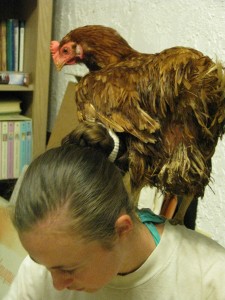
A wet but relieved Madge deciding to roost on Miranda. Bedtime! Since she laid yesterday morning’s egg in the evening, the next egg had already been forming for today. She laid it, and although the shell was hard you can see the malformation on the shell as it formed next to the other egg. Poor sweet baby!

Malformed egg next to regular egg For the moment, the cats, dogs, tortoise, hens and quail are eating, taking meds and recovering. Next on my list for the afternoon? Clean the 90 gallon fishtank and the hummingbird feeders! That small cave on a remote island sounds mighty good sometimes. Of course, I’d probably end up feeding the bats.
-
The Vine that is Eating the Chair

The flowers dangle in the breeze, always watching…. A curiosity plant in my garden is Dutchman’s Pipe (Aristolochia trilobata), also unpoetically called birthwort. The flowers aren’t actually pretty. The politest description of them is that they resemble a large pipe. The flowers dangle in the breeze from the vine, which is evergreen with glossy leaves. It doesn’t produce a fruit.

Kind of like a pipe; kind of like a nose. Dutchman’s Pipe is an ornamental, fast-growing vine that can grow 20 -30 feet in all directions. Including up. Up and up. Onto the second floor balcony. And around everything in its path.

Climbing two stories and beyond. In other words, the vine is eating my balcony and my patio furniture.

I’m glad I wasn’t asleep in it! Dutchman’s Pipe emits weak unpleasant odor when disturbed; otherwise the flowers don’t have a scent. It grows so quickly that the idea of pruning it down is daunting but must be done (… what is that tapping sound I hear on the sliding glass door right now?). It twists and winds around and up the posts to the roof (… hmm… are the cats in the attic again? I’ve never heard them make thatnoise). Soon it will probably be over the roof, and I’ll have an unmanagable amount of vines to clip and haul to the compost heap (… excuse me, someone is at the door. “Hello? Who’s there? Hello?”). I’ve been putting the job off, but today seems like a good day to….. (“What the heck is…. nooo!!…

NOMNOM -
Fowl Fortress
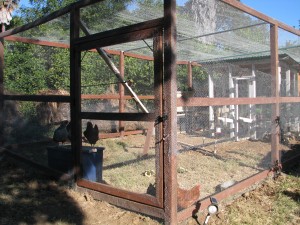
Front of Fowl Fortress I wanted to protect my hens from rats, snakes, weasels, raccoons, hawks and possible nuclear destruction, so I had the Fowl Fortress built. I was going to try to do it myself (ever taunting the gods of construction with my ineptness in this field). I bought Redicrete, t-posts and aviary wire. Then I came to my senses. I’m having shoulder and back problems, I wanted the coop to be done by the time I left to pick up my daughter from Oregon last week, and I really didn’t want the coop to be an eyesore.
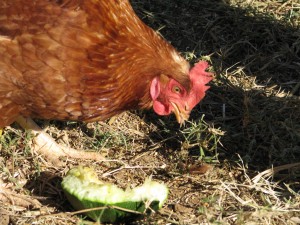
Partially blind Madge enjoying zucchini And I only wanted the best for my girls!
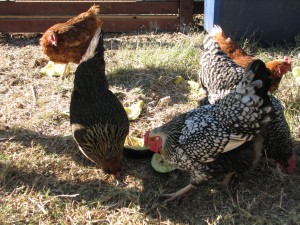
L-R: Viola, Chickpea, Miss Amelia, Lark and Madge So I hired the contractor who put up my wooden fence a few years ago. He said he’d do it over the weekend. Of course, not only didn’t it get done until 7 pm the night before I left the state, but he’d run over a whole lot of plants with his trailer, broke an irrigation line and a small tree, was scooping buckets of pond water to use for the cement because he didn’t see the HOSE and HOSE BIB that was right there (I found two buckets left over the weekend, and they had live mosquito fish and a pond snail in them! Ummm… habitat area! No-kill zone! Gee!). Frustration mounted and didn’t make my tension headaches go away despite chiropractic adjustments. And the coop was far more expensive than I had imagined. Survey question: how many of you who have had a construction project, have been given a no-show excuse of “a broken water heater in San Diego (substitute a city that is close but not too close) ? For me, it has been two contractors who have used that excuse. I’m catching on.

The side view. A solar light is in the ground for nighttime protection. Still, I ended up with a nice-looking, sturdy coop. It has a wire roof, and the wire goes down a little ways into the soil, but on one side the rats can still scoot under, so I need to secure it with rocks and more dirt. The girls love the coop because they can range around during the day safely, and they have plenty of good dirt bath places as well. I had a 4-foot door installed so that I could get large things in and out. Aviary wire is small-gauge wire, smaller than poultry wire. It should keep most vermin out. It is doubled at the bottom which will help keep small snakes from getting in or getting caught in it. I can also subdivide the coop on the inside if I wanted to put other birds in there (frizzles? ducks?) and keep them from being pecked by the ladies.

The coop doors are open all the time now. The two coops are inside and the girls mix it up when it comes to egg laying. I want to get the quail run inside, too, but it will take a little more lifting power than just my daughter and me. I’ve moved it myself, out of the truck and down the property, by leverage, ramps, and tilting it over onto my garden cart so that it is balanced on part of the roof. I tried that again the day before I left, but the ground was sloped and I lost control of the whole thing. I managed to get it back down for the quail and only did minor damage to myself. Wonder Woman I am no longer!
-
Summer is Here!
- Compost, Gardening adventures, Permaculture and Edible Forest Gardening Adventures, Soil, Vegan, Vegetables, Vegetarian
Fava Beans
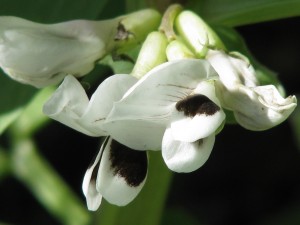
Fava flowers Have you ever eaten Italian, Greek or Middle Eastern food and found some enormous beans in it? Most likely those were fava beans. Commonly called broad beans or horse beans, these ancient beans are native to Africa and Asia, but can be found in cuisines worldwide.
There are a lot of reasons to grow them, even if you don’t eat the beans. First of all, they are nitrogen fixers, being a legume. However they don’t tendril like green beans do. The plant is a tall stalk (different varieties grow different heights) that sets beautiful flowers down the trunk. From these flowers grow some very weird-looking veggies. The pods look like clusters of swollen green fingers, I kid you not. The stalk can grow unsupported, but may topple over once the heavy pods are set.

Another reason to grow them is that they are hardy and can tolerate cold, and soils that are heavy in clay and salts (which pretty much describes my yard). Often broad beans are grown as a cover crop, then cut and allowed to decompose on the soil surface while the roots release the nitrogen under the soil.
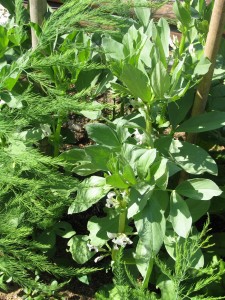
Then there is the reason that these very industrious plants produce an interesting protein-rich bean that enjoys notoriety worldwide (hence, easy to find different recipes for them!). The young leaves and flowers are edible as well.
To harvest favas, pull the swollen (but not too lumpy or they’ll be tough) pods from the stalks. Here comes the drawback: you have to shell the beans and it is a chore. Turn on a movie, pull up a bag of fava beans and an empty compost bucket, and go to. You may want to use a sharp knife to run down the seam, but I just used my fingernails. I watched the 1980’s TV show Cheers, which I never saw because I haven’t had television in about 17 years. Three episodes and I finished a big bag of favas!

When you’ve shelled the beans, you must blanch them for 3 minutes, then drop them in an ice bath. Rub the beans to remove a waxy coating. Then you can sautee them, mash them with potatoes, use them in fritters and soups, try an exotic Middle Eastern recipe with them. Fry them until they are crisp and serve salted as a snack. If you want to freeze them, then give the beans the blanch and ice water treatment, dry them and freeze them on a cookie sheet. Put them into a freezer bag. When you want to use them, then thaw, remove waxy shells and use. Some people don’t remove the coating, but its better if you do.
Fava beans have a nutty, slightly bitter and earthy flavor that becomes quite addictive. Two warnings, though. Some people, particularly those of Mediterranean decent, may be allergic. Also if you are taking anti-depressants, the beans are rich in tyramine and should be avoided by those taking monoamine oxidase (MAO) inhibitors – a type of medication used to treat severe depression.

Add fava beans to your garden and landscape. Just tuck the seed into the ground and stand back. Mine weren’t nibbled by rabbits or bothered by anything; however last year I grew six plants in a raised bed, and something opened all the pods and ate the beans. This year I have them planted all over the property to help build the soil, and the harvest appears to be all mine. I’m glad that Cheers ran so many seasons!

-
Melting Birds
Perhaps you’ve noticed birds doing strange things. I certainly have. Often they glance around afterwards to see if anyone is watching. One very silly-looking thing birds do is sun themselves. They will spread their wings to catch the most warmth, then go into kind of a trance.

Western Bluebird They’ll put their heads to the side and simply melt in the sun. Often I’ve wondered about the safety of their balance.

High wire act But they always seem to come out of it okay. I’ve seen many different kinds of birds melting in the warmth, taking a sun bath. Usually it makes me want to do the same.

Western Bluebird against heat-reflecting fence. - Bees, Compost, Gardening adventures, Health, Heirloom Plants, Other Insects, Permaculture and Edible Forest Gardening Adventures, Soil, Vegetables
Integrated Gardening

Wildflowers, tasty borage, milkweed for the Monarch butterflies, and herbs. There are still those who prefer to have all their plants separate, each plant type confined to its own space. Vegetables should definitely not be allowed in the flower garden; herbs may be there only if more ornamental than useful, but don’t ever mix desert, country cottage or rose gardens together. That style of design is a matter of preference, and many gardens following those rules are very beautiful. They are usually also high maintenance, heavily fertilized, watered and sprayed, with poison set out for rodents.

A breadseed poppy is emerging in the sage. The blending of useful and ornamental plants is certainly not a new idea, and yet it isn’t often done. When it is, gardeners should find that the loss rate of plants to pests is quite low, and the yield of the vegetables is high.

Onions, native mallow, tarragon and sweet potatoes under a white fringe tree. Why is this? For one thing, planting mixed seeds which include ornamentals, herbs and vegetables masks the scent of the most yummy plants from its preditors. There aren’t rows of the same type of plant for the insects to find. Since different plants take up different nutrients from the soil, the soil isn’t depleted of one particular nutrient, so mixed plantings usually make for healthier and tastier plants.

My first tomatoes of the season, off of a volunteer along the pathway. Oh so yum! Wildflowers with cilantro, dill and basil not only are more successful and appealing to look at, but if let go to flower are excellent pollen sources for bees.

Young parsley, California poppy, cilantro and dill by rain lilies. Allowing desirable plants to reseed not only saves you money, but makes the new plant hardy and adapted for your particular garden.

Volunteers are welcome, such as this squash. Of course mixing plants is what an edible forest garden is all about, although the mixing isn’t random. Each plant serves a purpose. I use fava beans as a great edible nitrogen-fixer, along with other beans, peas, sweet peas, lupine, and nitrogen-fixing trees and shrubs. Artichokes grow quite large, and their leaves when cut and left on the ground make superb compost, as do the leaves of comfrey. Artichoke leaves keep growing back, and the plant will produce many very yummy artichokes. (Artichoke hint: wipe Vaseline around the stem below the bud to keep ants and earwigs from finding their way between the leaves.)

Artichoke and fava beans beneath an apricot tree. Melons and squash make an incredible ground cover during the hottest months. Their large leaves shade the soil surface and block evaporation. Remember that raccoons aren’t supposed to like going through squash vines, so plant them around your corn.

Green melon and corn by a variegated lemon (Sophie the dog by the car). Integrating your plants, especially when following the edible food forest guidelines, helps increase soil fertility (different plants remove different things from the soil). Mostly this is done by keeping the soil a more moist and inviting habitat for soil microbes and worms, but also by dropping their leaves which become mulch.

A guild: kabocha squash, heirloom squash and gourd (on wire) with onions interplanted to keep seedlings safe, along with something else that I don't remember planting, wildflowers, artichoke (under the milk carton for bunny protection), scented geraniums, lavender, borage, orgeano, sweet potatoes (not up yet), cowpeas, fava beans and Swiss chard by a small avocado tree. -
Edible Food Forest
This is a cheat blog, because I’m simply going to give you a link to a newspaper article. This is about land that has been dedicated to an edible food forest, which the public may enjoy. I hope it is the beginning of a new government trend to help feed the hungry. It also has a nice diagram about what a food forest may look like. Here it is: http://www.theepochtimes.com/n2/united-states/food-forest-takes-root-in-seattle-242907.html .
